
These Small Towns on the Gulf Coast Have the Best Historic Districts
A historic district is defined as any location preserving the history of a locale and ranges from important commercial properties to private homes of historical significance or landmarks deemed to be worthy of preservation. The Gulf Coast region encompasses five states bordering the Gulf of Mexico: Florida, Alabama, Texas, Mississippi, and Louisiana. Each state offers a variety of small towns brimming with historical charm. The following list includes locations that reflect a wide range of historical significance from sites that highlight some of the largest plantations in the United States to homes of famous Americans, including authors and military leaders. Here is a list of ten small towns on the Gulf Coast that have the best historic districts.
Dunedin, Florida

Aerial view of a residential house with a pool in downtown Dunedin, Florida, in the Tampa Bay area near the Gulf of Mexico, showcasing the city and roads during summer.
Located in the Gulf State of Florida, Dunedin is rich with history, and its historic district is an attractive, bustling local with plenty of shops and restaurants. Dunedin also enjoys the distinction of being one of the oldest cities on the west coast. Established in the 1850s, the town’s name derived from settlers from Scotland who initially named the town “Dun Eideann,” which is a derivative of the Scottish town of Edinburgh. Dunedin is home to the historical Orange Belt railway, a narrow-gauge railway constructed in 1888, and built to connect the Tampa Bay region, through Dade City, and on to Sanford, Florida. Parts of this railway remain intact to this day and can be seen at the Dunedin Historical Museum. The Orange Railway enabled Dunedin to become a major trading center in the area. Dunedin also enjoys proximity to award-winning beaches and shopping, and is home to the Toronto Blue Jays during their Spring Training season, making Dunedin an appealing place for those who enjoy spending time in a historical railway town.
St. Augustine, Florida
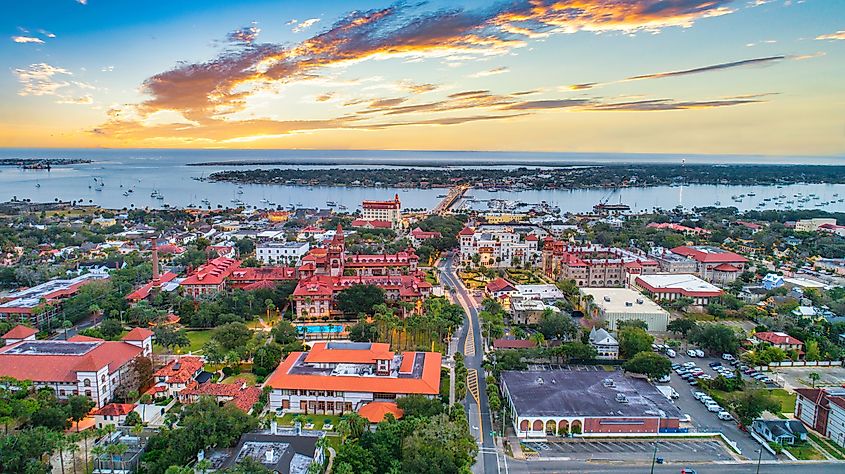
Drone aerial skyline of downtown St. Augustine, Florida, USA.
Home of the oldest European settlements in the United States, St. Augustine is located on the Northeastern portion of the State between the Matanzas and Saint Sebastian saltwater rivers, enjoying an expansive historic district with shops, hotels, and tourist attractions. Proximity to these rivers provides access to the Atlantic Ocean via the St. Augustine outlet. History buffs will enjoy their time in St. Augustine, with its brick-lined streets, old-world architecture, and horse-drawn carriages. Built in 1672, this locale is home to the Castillo de San Marcos, the oldest fort within the continental United States. This fort was a very important location during the Spanish and British conflict, and once it fell into the possession of the British, they renamed it Fort St. Mark. In 1924, it was declared a National Monument, and by 1942, its original name of Castillo de San Marcos was restored. Tours, such as the Historic Tours of Flagler College, formerly known as the Hotel Ponce de Leon, offer guests a chance to experience architecture inspired by old-world Europe. St. Augustine is also home to the stunning Vilano Beach for those seeking a little rest and relaxation after taking in the history of this charming location.
Florence, Alabama

Long exposure of O'Neal Bridge at night, spanning the Tennessee River between Florence and Sheffield, Alabama.
Located along the Tennessee River, Florence, Alabama was founded in 1818 largely due to investors who saw great potential for a trading center within this local. It is home to ten historic districts, including the Cherry Street Historic District, and the Wood Avenue Historic District. These locals reflect their historical charm through the various architectural styles of their homes and buildings. Also, the historical architectural marvel known as the Wilson Dam can be found here. This dam is the only neo-classical style dam in the country incorporating Ancient Roman and Greek Architecture. The Dam was constructed to supply power to surrounding areas and is a must-see when visiting Florence. The Florence Indian Burial Mound and Museum is also located here, where ice-age hunting implements are on display and the 43-foot-high burial mound, which guests are welcomed to climb, following in the footsteps of ancient Indian chiefs. Florence is home to the world-famous architect Frank Lloyd Wright’s Rosenbaum House, built in the 1930s, which is open to the public and presents a delightful glimpse into the not-so-distant past.
Irondale, Alabama
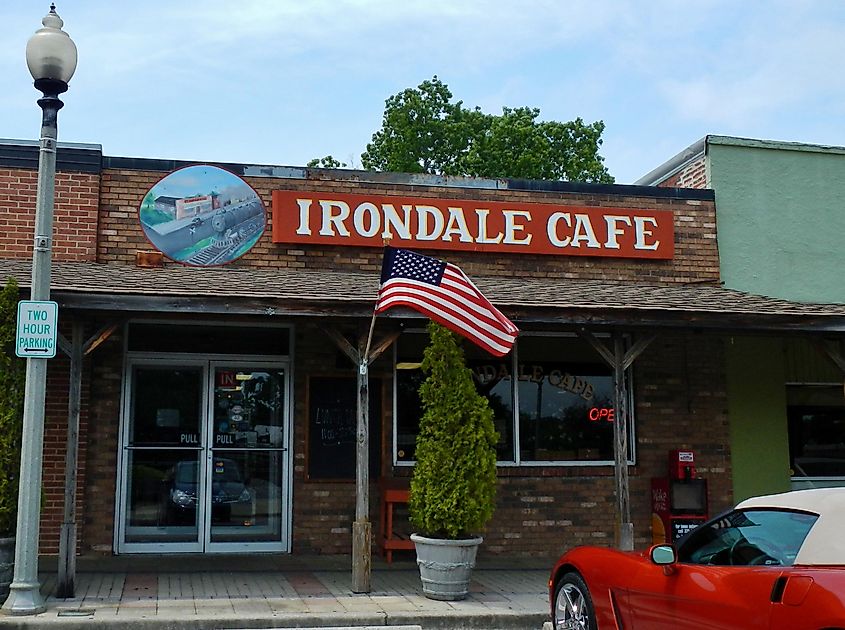
Incorporated in 1887, the historic mining town of Irondale, Alabama, gets its name from the ironworks furnace that operated in the area long ago and unofficially represents its historic district. This ironworks furnace was originally known as Cahaba Iron Works, but the locals called it Irondale. The historical significance of this locale dates back to the era of the Civil War when the ironworks produced pig iron. This material was used to create ammunition for the Confederate army during the Civil War. In 1865, a fire destroyed it, but it was eventually restored and used to produce farming implements. This location is also famous for its Red Rock, which is rich in iron ore and Indians used this material to make red dyes and face paint. Visitors will also enjoy visiting Irondale’s historic Cahaba Landing, located along the Cahaba River, consisting of a 1.5-mile nature trail, including a canoe launching site to access the river for fishing or enjoy time on the water.
Port Gibson, Mississippi
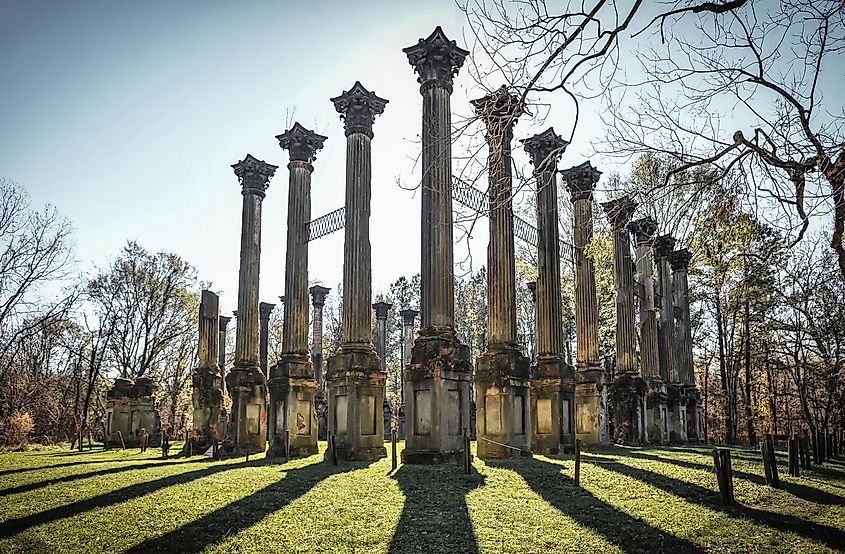
Windsor Ruins in Port Gibson, Mississippi, showing the remains of the historical columns.
Chartered as a town in 1803, Port Gibson is an attractive location for history buffs interested in learning about the antebellum-era architecture within the downtown area where many of the homes and buildings here are listed in the National Register of Historic Places. One of Mississippi’s largest plantations, the iconic Windsor Plantation is also located here. The plantation’s Greek revival mansion was once the largest in the region, but all that remains are the historic Windsor Ruins, which consist of 29 monstrously large columns, giving insight into how large the plantation was in its prime. Reliant upon slave labor, the plantation’s mansion was ultimately destroyed by fire in 1890. Port Gibson is also the location of the Grand Gulf Military Park, the home of former President Ulysses S. Grant, exhibiting the Confederate Memorial Chapel, a carriage house, hiking trails, and a campground.
Oxford, Mississippi
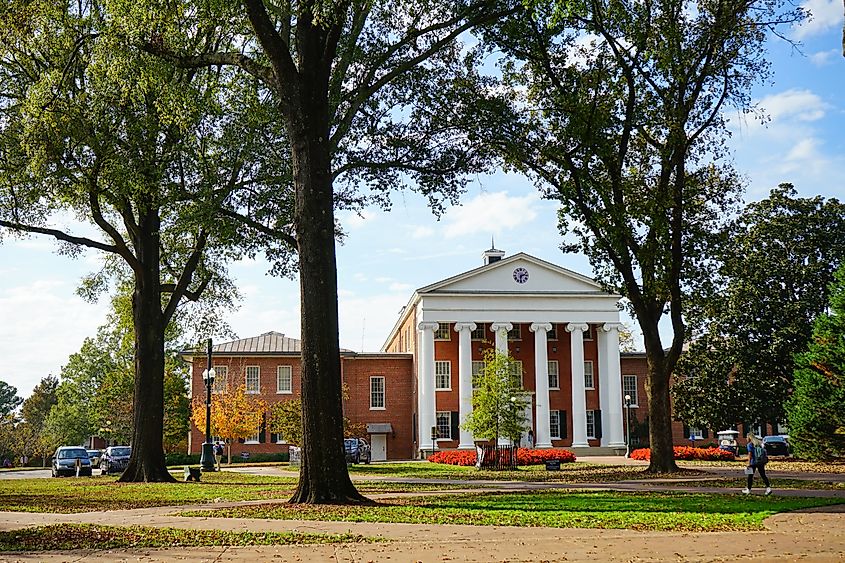
University of Mississippi campus building in Oxford, MS, USA. Editorial credit: Feng Cheng / Shutterstock.com
Established in 1837 and named after the city in England, Oxford, Mississippi, locale landmarks put Oxford on the history lover’s map, including the iconic St. Peter’s Episcopal Church, built in 1851, as well as the Rowan Oak Mansion, built in 1840. St. Peter’s Episcopal Church is noted to be the first cathedral in the diocese, with author William Faulkner as one of its parishioners. The Rowan Oak Mansion was home to the Pulitzer Prize-winning writer and history lovers will enjoy a chance to experience it up close, seeing how the famous author spent his days. Faulkner purchased the 1930s-era Greek Revival home which sits on 4 acres of hardwood forests and named it after the Rowan trees that grow on the property, representing symbols of security and peace. Oxford boasts a vibrant cultural scene and is known as the cultural mecca of the south and is a popular location for artists and musicians.
Natchitoches, Louisiana
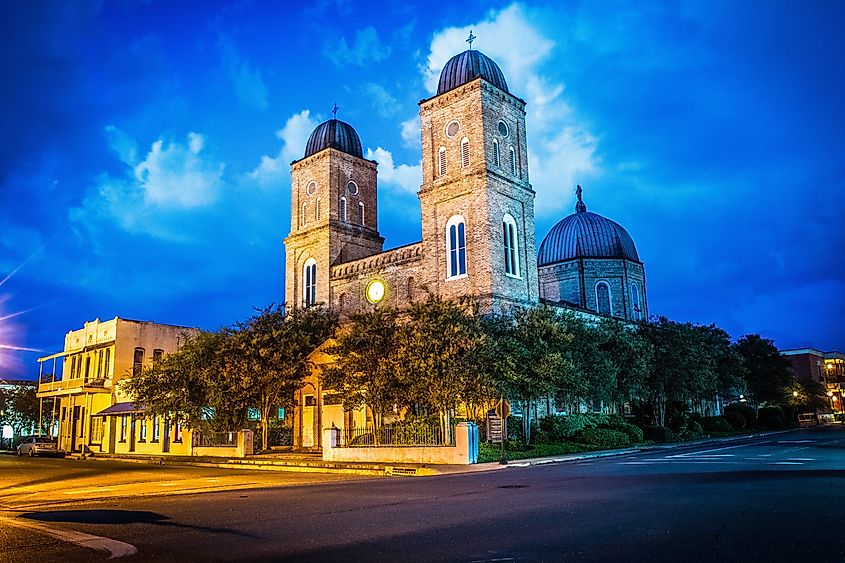
Light trails at the Minor Basilica in Natchitoches, Louisiana.
Established in 1714, Natchitoches is the oldest European settlement in the state of Louisiana, and its main industry was the cotton trade in its early years. These days, however, the town’s main industry is tourism. Natchitoches consists of four historic districts and a mixture of French, creole, Indian, African American, and Anglo cultures. These historic districts are home to Creole architecture, brick-lined streets, and former plantations, comprising various historical attractions. The Cane River National Historic Park is home to the Oakland plantation, among others and a visit here offers access to the original plantation outbuildings including the plantation store, sleeping quarters, cotton press, and blacksmith’s shop, among others. Exploring these locals offers a glimpse into life on a plantation and represents an important part of American history. Visitors are welcome to enjoy guided tours through the historic district, riverboat, and horse-drawn carriage tours. Another interesting point of interest regarding Natchitoches is that Steel Magnolias was filmed here.
St. Francisville, Louisiana

The Historical Grace Episcopal Church was built in 1860 on Ferdinand Street in St. Francisville, West Feliciana Parish, Louisiana. Editorial credit: Nina Alizada / Shutterstock.com
Home to several significant plantations, including the historic Rosedawn Historic Site, St. Francisville greatly appeals to history lovers. The Rosedawn Plantation comprised 3,455 acres, producing mainly cotton, and was so prosperous it made the owner at the time, Daniel Turnbull, one of the wealthiest men in the country. He and his wife used their wealth to build the home that resides on the plantation now and spared no expense in decorating and furnishings. Construction on the property was completed by 1835. Tours are now available of their home as well as the plantation’s many outbuildings. The plantation’s prosperity was due to the number of slaves the owners had, numbered in the mid-400s at the height of its production. The plantation was sold in 1956, and its new owner initiated the estate’s restoration, complete with its own horticultural gardens. St. Francisville is also home to the Audubon State Historic Site, where John James Audubon spent his summer in 1821, compiling illustrations for the book Birds of America.
Paris, Texas
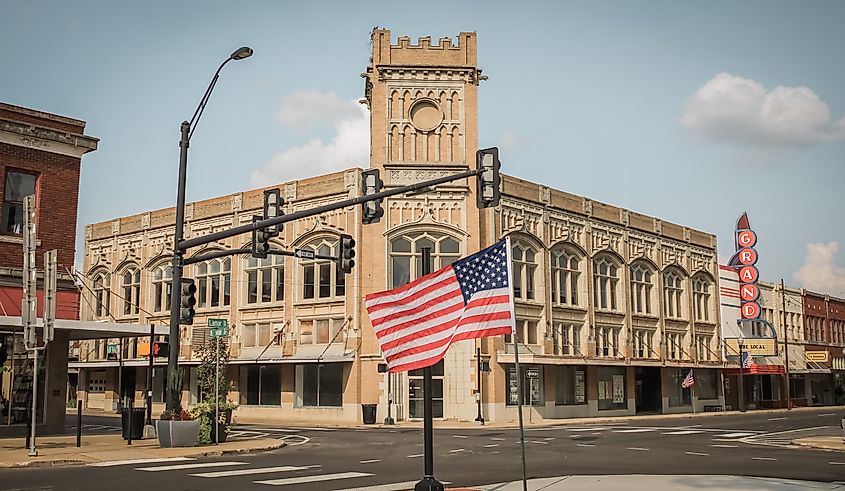
The town square in Paris, Texas, United States. Editorial credit: Sabrina Janelle Gordon / Shutterstock.com
Paris, Texas is a former railroad center that has survived two major fires since it was incorporated in 1845. It is home to two historical districts established in 2004 including the Paris Commercial District and the Church Street residential district. Paris is also home to one of the State’s first Junior Colleges, the Paris Junior College, established in 1924. Visitors will be delighted to find the Eiffel Tower replica within the Church Street historic district, an exact replica of the Eiffel Tower in Paris, France, but built at approximately one-sixteenth the original size. A favorite site of note for history buffs is the Sam Bell Maxey House State Historic Site, a restored Victorian-era home belonging to Confederate General Maxey who was also a former US Senator. The home is furnished with the family’s original belongings. The award-winning movie “Paris, Texas” was filmed here as well, putting this locale on the map as an alluring and mysterious place, even though it was filmed elsewhere.
Bastrop, Texas
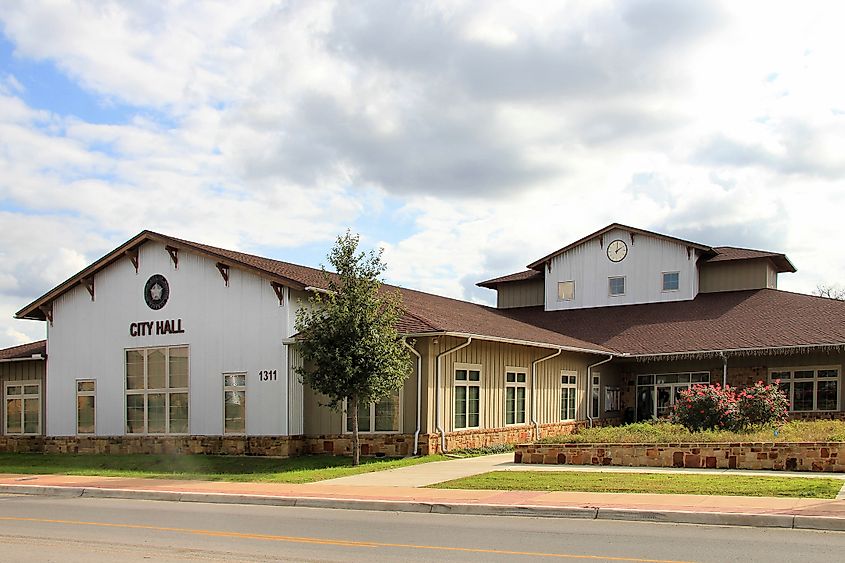
City Hall building in Bastrop, Texas, United States. By Larry D. Moore, CC BY 4.0, https://commons.wikimedia.org/w/index.php?curid=37284183
Bastrop, Texas is located along the riverbanks of the mighty Colorado River and is known to be a sleepy town brimming with historical charm. Established in 1832, Bastrop began as a small cluster of buildings consisting of a general store, a courthouse, a hotel, and a stockade, and it eventually became a bustling center for trade and commerce. These days, Bastrop’s streets are lined with buildings listed on the National Register of Historic Places. The Bastrop Museum and Information Center is the first stop visitors should make when coming to town where they will be met with over 200 years’ worth of artifacts and archives, mapping out the town’s heritage and is a popular place for historians, writers, and history buff’s to visit. Bastrop is home to over 130 historical locations including The Old Bastrop County Jail, built in 1892, reflecting a Victorian Era construction with three floors in total and designed in an ornate style featuring red bricks and yellow bricks in contrasting designs. The Downtown area of Bastrop is also full of historical appeal and the streets are lined with 19th-century architecture, featuring shops, galleries, and eateries.
The Gulf Coast's Timeless Towns
Whether it’s a glimpse into life on a plantation, the home of famous men of note, or everything in between, the Gulf States are full of locations that offer interesting and informative experiences for visitors seeking an opportunity to learn the history of the region’s rich and diverse past. Overflowing with historic architecture, cultural landmarks, and various historical buildings, the Gulf States offers many opportunities for history lovers to experience the past as it once was within the region’s States of Florida, Alabama, Mississippi, Louisiana, and Texas.











